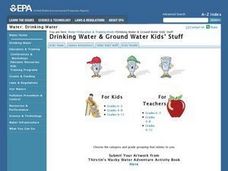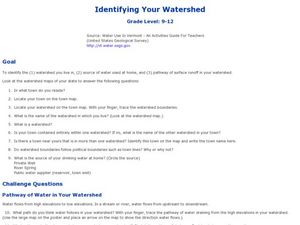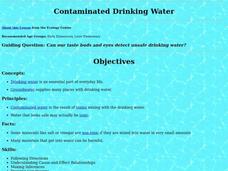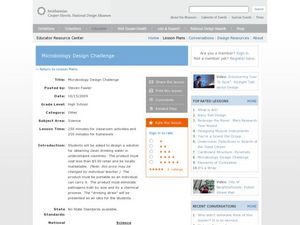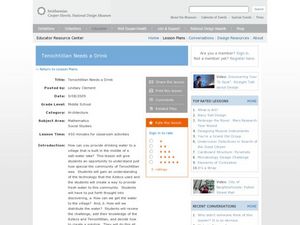Curated OER
Youth Activity: How People Get Their Water Reservoirs: "Holding Tanks" for Drinking Water
Students experience and participate in "Riding the Water Cycle" with this activity. They explore, analyze and study the role of reservoirs in maintaining a reliable supply of drinking water. Each student constructs a model of a reservoir.
Curated OER
Splish Splash
Learners study drinking water. In this environment lesson, students draw the path of drinking water from the place of precipitation to the tap after researching a map and information from the United States Geological Survey water...
Curated OER
LIFE ON THE MISSISSIPPI PAST AND PRESENT
Third graders explore the Mississippi River and the ways in which it is used by the communities it travels through.
Curated OER
Identifying Your Watershed
Students identify the watershed where they live and how it is related to their own water consumption. In this watershed lesson students locate their watershed on their town map. The students find the source of their water that they use...
Curated OER
Contaminated Drinking Water
Students explore water and determine whether or not it is safe to drink. In this water exploration instructional activity, students are split into groups, to acts as the polluter, taster, and recorder. Students explore by placing...
Curated OER
Contaminated Drinking Water
Students predict, experiment, and draw conclusions about the safety of drinking water. In this ecology lesson, students participate in an experiment to determine if they can taste or see contamination in drinking water. Data is collected...
Curated OER
TE Lesson: How Clean is that Water?
Middle schoolers examine the factors the affect water quality, and allow for animals and plants to live. They look at how engineers apply water quality information when making stream modifications in order to ensure drinking water...
Curated OER
TE Lesson: What to Wear? What to Drink? Weather Patterns and Climatic Regions
Students examine how climate affects lifestyle, clothing choices, food, and water sources. They explore climatic regions such as tropical, desert, coastal, and alpine situations. They look at the longitude and latitude, land features and...
Curated OER
Purification of Water
Students study the process of water purification and explain why it was important to treat it. In this water purification lesson students purify drinking water and explain the factors that affect water quality.
Curated OER
Drinking Water Around the World
Students explore the concept of water quality. In this drinking water lesson, students discuss the quality of water around the world, conduct research about drinking water, and then write essays about water quality.
Curated OER
Microbiology Design Challenge
Students discover dangers to human health by researching what's in our drinking water. In this water purification lesson, students discuss the conditions of water in undeveloped countries and why it is unsafe to drink....
Curated OER
Tenochtitlan Needs a Drink
Middle schoolers engineer a way to provide drinking water using Aztec technology. For this engineering a way to provide drinking water using Aztec technology lesson, students find a way to deliver fresh water to a city surrounded...
Curated OER
Harvest Water from Fog
Students investigate the different forms of water by turning fog into drinkable water. In this harvesting lesson, students discuss and observe photographs of fog and why it is essential for some countries to collect water from fog...
Curated OER
Contaminated Drinking Water
Students investigate drinking water. In this water lesson, students discover if the water we drink is safe by participating in an experiment. Students use water and vinegar to observe how drinking water can be contaminated.
Curated OER
Water Filtration
Young scholars explore, analyze, study and demonstrate the procedures that municipal water plants may use to purify water for drinking. They cover the clean water processes of aeration, coagulation, sedimentation, filtration and...
Curated OER
Straining out the Dirt
Students design and construct a water filter using activated carbon, cotton and other materials to remove chocolate powder from water. They test and record their observations, and complete a KWL chart.
Curated OER
Contaminated Drinking Water
Students see if they can tell if our water is safe to drink by looking at it and tasting it. They perform an experiment using salt and vinegar to see when they can tell water has been contaminated.
Curated OER
Rivers... for Kids
Students investigate U.S. geography by exploring it's bodies of water. In this river formation instructional activity, students identify the reasons rivers are needed in our country by reading assigned text. Students examine a diagram...
Curated OER
Is It Safe To Go In?
Students examine acceptable levels of toxins in swimming areas. Working in groups of four, students dilute a salt or sugar solution to 1 part per 1,000,000 (ppm) solution. Students taste test their diluted liquids and record at which...
Curated OER
Drink It Up!
Students investigate how the human body needs water by recording their water consumption for a day. They sing a song about drinking water, make and drink Kool-Aid and eat apple slices, and conduct an experiment to determine how much...
Curated OER
Science: Headline
Students are able to identify questions they need to answer to comprehend a specific news article. They are pushed to question how they know that their drinking water is safe.
Curated OER
This Stuff Makes Me Sick
High schoolers participate in a lab showing the effects of pesticides on Lumbriculus variegatus. Several extensions and variations are also included in this instructional activity including one which relates the experiment to how...
Curated OER
The Surprise of the Blue Water
Students become aware of factors that effect drinking water quality and how this could effect the health of their school environment. Students compose a business letter reporting their school water quality results to an appropriate...
Curated OER
Drink It Up???
Students research and record facts about well, lake, and tap water. They increase their computer skills for research, creating a spreadsheet, and word processing.


